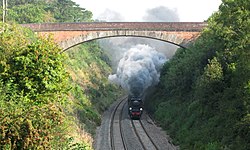Bristol to Exeter line
| Bristol to Exeter line | |
|---|---|

|
|
| Overview | |
| Type | Suburban rail, Heavy rail |
| System | National Rail |
| Status | Operational |
| Termini |
Bristol Temple Meads Exeter St Davids |
| Operation | |
| Opened | 1841–1842 |
| Owner | Network Rail |
| Operator(s) | Great Western Railway, CrossCountry |
| Rolling stock |
Class 43 HST Class 143 "Pacer" Class 150 "Sprinter" Class 153 "Super Sprinter" Class 158 "Express Sprinter" Class 220 "Voyager" Class 221 "Super Voyager" |
| Technical | |
| Number of tracks | 2 |
| Track gauge | 4 ft 8 1⁄2 in (1,435 mm) standard gauge |
| Operating speed | 100 mph (161 km/h) maximum |
The Bristol to Exeter line is a major branch of the Great Western Main Line in the southern United Kingdom and runs from Bristol, to Exeter, from where it continues as the Exeter to Plymouth line. It was one of the principal routes of the pre-1948 Great Western Railway which were subsequently taken over by the Western Region of British Railways and are now part of the Network Rail system.
The line was built by the Bristol and Exeter Railway with Isambard Kingdom Brunel as the engineer. The section from Bristol to Bridgwater was opened on 14 June 1841 and it was completed to Taunton on 1 July 1842. It was initially operated by the Great Western Railway as an extension of their line from London Paddington station and formed part of the 7 ft (2,134 mm) broad gauge trunk route to Penzance on which through trains were run from 1867, but in the same year the section between Highbridge and Durston was reconstructed as a mixed gauge line to accommodate local 4 ft 8 1⁄2 in (1,435 mm) gauge traffic. The remainder of the line was laid with mixed gauge by 1 June 1875 and broad gauge trains ceased operation on 20 May 1892.
...
Wikipedia
